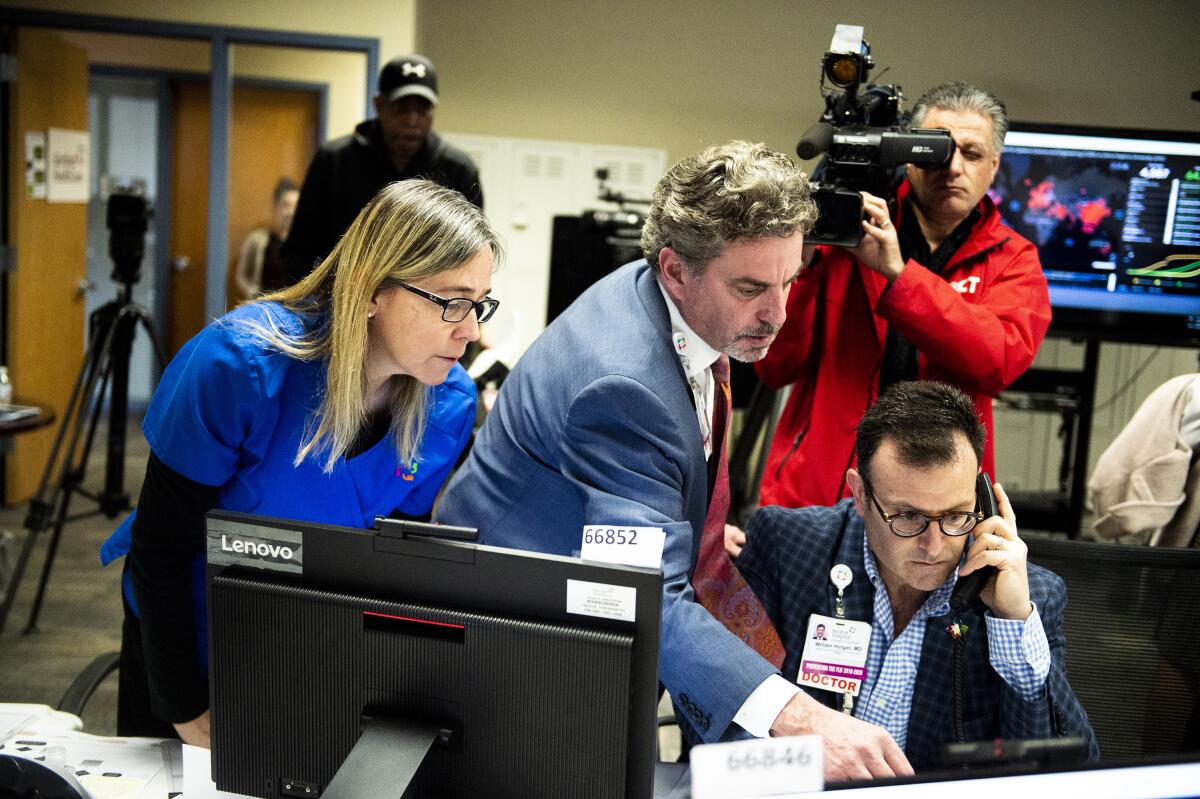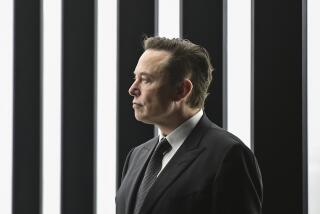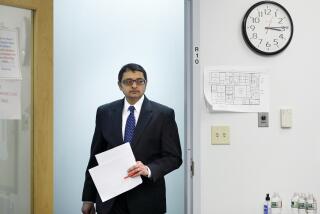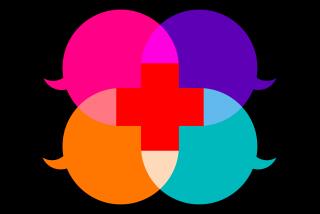Apple and Google won’t solve coronavirus contact tracing. Here’s what will

- Share via
A middle-aged woman arrived at a tent set up by St. John’s Well Child and Family Center for coronavirus testing on April 13, her mother in tow. When both tested positive, clinic staff began to ask more questions.
Can you give us the names of people you have been in close contact with? We need to make sure your family and friends and co-workers are safe, staffers explained. It turned out the women shared their two-bedroom apartment near Figueroa and 50th Street in South Los Angeles with two other families —14 household members total.
Within the next two days, clinic staff were able to contact and persuade other household members to come in for testing, said Jim Mangia, chief executive of the nonprofit, which operates 18 health centers and school-based clinics in Los Angeles and Compton. One other housemate tested positive.
With California and neighboring regions working to relax social distancing restrictions and allowing parts of life to return to normal, health authorities are racing to stop the next wave of infections before it starts. To avoid an explosion of new cases, Gov. Gavin Newsom has stressed the state’s ability to trace the trail of people exposed to the novel coronavirus in order to isolate and treat them.
Many have pinned their hopes for a return to normal on a regime of digital contact tracing powered by Google and Apple smartphones. The two rival companies are working with public health authorities and university researchers to build groundwork into mobile devices for apps that would notify people if they were recently in proximity to someone who was infected. They plan to release the system in mid-May. Newsom has praised the rare joint effort, and President Trump has called the technology “an amazing thing” and “very accurate.”
But all the attention on the Google-Apple platform has some public health professionals nervous. The job of contact tracing, they say, defies the notion of a sleek tech fix, requiring labor-intensive work by trained individuals. Those who’ve used it successfully to keep other diseases in check worry that an untested constellation of apps is already being treated as a panacea despite the United States broadly facing an absence of other necessary elements in any successful response: widespread, freely available testing and the hiring and training of tens of thousands of human contact tracers who can explain, cajole and make nuanced judgments.
The story of the 14 housemates helps illustrate why. The mother who accompanied her daughter to the clinic that day was an undocumented immigrant, putting her in a category of patients who are often wary of having their personal information entered into databases. But as a longtime patient of St. John’s, she was comfortable with staff interviewing her, Mangia said. Relationships are key, he said, especially in low-income black and Latino communities that are most vulnerable to the coronavirus, such as those in South L.A.
“I’ve been doing this for 25 years. I find it hard to believe an undocumented patient would be comfortable with an app that alerts you to someone next to you that has been exposed to COVID,” Mangia said. “That’s a pretty big stretch.”
With many patients who don’t speak English or have phones with fast internet connections, St. John’s has had limited success in its ability to get them to use new apps for telehealth visits or appointment scheduling, he said.
“We’re finding if we use WhatsApp or FaceTime or just a plain old telephone call, it’s much, much more effective,” he said.
But interviews take time and can tell you only as much as the interviewee knows. The speed of the virus’ exponential spread has kindled a demand for new methods to automate and scale contact tracing. With a near-total duopoly in smartphone operating systems, Google and Apple, in theory, have the power to create a vastly comprehensive technology — one that could tell you whether you need to worry about that stranger who stood too close to you at the bus stop. Relying on the short-area Bluetooth radios inside every smartphone, it would be immune to the whims of patients, able to capture interactions they forgot about and encounters with strangers.
“You’re never going to remember the people on Subway car 5 on the 5 p.m. train,” said Ranu Dhillon, an epidemic-response specialist and instructor at Harvard Medical School. For every person that discovers they have been exposed through the app and reports that to a public health department, that’s one more transmission chain that might not have otherwise been discovered, Dhillon said.
But relying on an app is technocratic folly, said Allyson Pollock, a professor and director at the Newcastle University Centre for Excellence in Regulatory Science. “It’s very superficial. It appeals to the middle classes — to the prosperous — but it’s actually no good if you think you can control an epidemic with it,” she said.
As more states reopen, an army of contact tracers will have to be enlisted to join the effort to stop the coronavirus.
The bedrock of infectious disease containment, interview-based contact tracing is the tried-and-true strategy health departments must invest in and the public should put its faith in, experts said. Scores of health investigators trained to interview patients, call people they interacted with, knock on doors and flag down strangers in search of those who might have been exposed have been crucial in containing sexually transmitted diseases, measles and tuberculosis, as well as the outbreaks of SARS in 2003 and swine flu in 2009.
Massachusetts was the first state to invest in an ambitious coronavirus contact tracing program, budgeting $44 million to hire an army of 1,000 contact tracers. Gov. Andrew Cuomo said April 22 that New York would partner with New Jersey and Connecticut to launch a similar program. On the same day, Gov. Newsom said California was revving up to train as many as 10,000 people.
However, the country overall is woefully unprepared to deploy the estimated 100,000 to 300,000 contact tracers needed to tackle the coronavirus. An NPR survey of all 50 states found that the United States has just 7,602 workers doing contact tracing, with plans to bolster that number to 36,587.
Overconfidence in tech solutions could detract from these needed efforts and provide a false sense of security to justify reopening local and national economies well before it is safe to do so, three experts in technology, law and policy, and epidemiology wrote in a paper for the Brookings Institution. The authors also warned that the apps could be exploited to sow chaos and disinformation and identify infected individuals without their consent.
Apple and Google say the architecture they adopted puts privacy first. To keep users anonymous from each other, and anyone else attempting to keep tabs on them, the data broadcast and collected via Bluetooth will be encrypted, and the phones’ identifiers will change every 15 minutes or so.
Explicit user consent will be required before the tool starts collecting data on one’s operating system. An individual diagnosed with COVID-19 would enter that information into a health agency app and consent to submitting a record of other phones it has been close to, which would be stored on a remote server for 14 days. Any user whose phone appears on that list will receive a notification with information from health agencies about how to self-isolate and monitor for symptoms.
With these safeguards, the plan has mostly won cautious approval from privacy advocates, including experts at the American Civil Liberties Union, despite widespread concerns about tech giants’ hold over people’s personal data.
Still, the looming specter of privacy concerns could keep enough people from opting into the system to prevent it from reaching the critical mass required to generate meaningful results. Nearly 60% of respondents to a recent Washington Post-University of Maryland poll said they would not participate in digital contact tracing, because of either privacy concerns or technological hurdles.
With such low participation, the likelihood of an infectious contact being flagged by any app would be extremely low, said Farzad Mostashari, a former national coordinator for health information technology at the Health and Human Services Department during the Obama administration.
When two people come into proximity, the chance that both have the app would be “like rolling a double six,” he said.
Silicon Valley can come up with apps that might free Americans from home confinement. But Washington fears creating an invasive surveillance system.
The companies have not said how many users would need to opt in for the contact tracing technology to work effectively. But an Oxford University study found that governments need 60% of the population to use a Bluetooth-based app to stop the spread of the coronavirus.
In countries that have successfully used high-tech tools to suppress coronavirus outbreaks, they’ve generally been paired with widespread, old-school contact tracing methods, and sometimes with notable curtailment of personal privacy and punishments for defying public health edicts.
In South Korea, for instance, cellphones ping with alerts whenever new cases are discovered nearby. Health authorities regularly publish the exact times and routes of infected persons’ movements. People ordered into self-quarantine must download an app that alerts officials if they leave isolation; fines for violations could reach $2,500.
There are signs of more countries taking this route. France has urged Apple and Google to weaken privacy restrictions, to no avail, and the United Kingdom’s National Health Service has said it will create its own centralized system.
Meanwhile, the limited nature of the data the apps generate will make it impossible for public health departments to centralize information and understand transmission chains and where exactly outbreaks are occurring, or to create a list of a patient’s contacts for follow-up.
Users who receive notifications may find it difficult to understand their real level of risk. The result could be a blizzard of false positives — reports of exposure even when the possibility of transmission was very low, said Carl Bergstrom, a professor of biology at the University of Washington who coauthored the Brookings article.
It’s the context that lets trained contact tracers zero in on the meaningful interactions, Bergstrom said. “Humans talk you through your day,” he said. “Who did you have conversations with? Did you say hi to your neighbor? Where was she standing? You work through that stuff. It allows humans to make nuanced judgments about what is considered an exposure.”
An Apple spokesperson said in an email that exposure notification technology is only one element of response to COVID-19, though Apple and Google have heard from public health authorities that it can be a useful instrument. The spokesperson said the companies acknowledged that learning the most effective methods of managing the virus is a constantly evolving process. The companies originally called the system a “contact tracing” tool, but have since rebranded it as “exposure notification.”
It’s not that technology can’t be helpful here, Mostashari said. Tools that directly assist with manual contact tracing efforts, such as training contact tracers, streamlining questions they should be asking and improving public health departments’ ability to follow up with patients daily, might be helpful, he said.
San Francisco, which is training librarians, city workers and medical students to do contact tracing, has partnered with Dimagi, a company developing open-source software for underserved communities, to digitize the workflow supporting contact tracing and monitoring those with COVID-19.
But until the technology has proved its merit, Bergstrom said, there is every reason to be skeptical.
“Maybe some tech solution will pass epidemiological muster, but right now, I don’t see what that is,” he said. “What we’re cautioning is, let’s not put all our hopes on this. Let’s be transparent about what it can do.”







